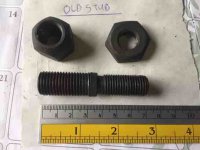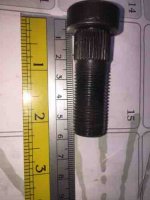zimbo
Aluminum
- Joined
- Apr 22, 2017
- Location
- Richmond, VA
Afternoon Gents,
I have been recently been purchasing wheel hub castings and machining them myself. So far have done 8 and need another 25 or so to do this year.
The hole pattern is the the same as a land rover 5 stud pattern using 7.60x16 tyres. The hubs have 30209 bearings and I am using them on my trailers to cart tobacco and various farm stuff. No highway work. PCD is 165mm.
Attached are pictures of the old style wheel studs we have been using for decades here and are not great. A local bolt manufacture has made these for me but are quiet expensive and am looking for an industry standard stud with similar dimensions. Have contacted couple vendors in SA and just waiting on their reply.
The castings are not the greatest quality and have already sent back 2 out of the 12 I have bought. Some are really hard even once you get under the foundry scale.
How many mm should the knurl be to bite into the Hub without peeling the knurl back. Currently the knurl is at 17.3mm OD and the hole 16.5mm and is peeling the knurl back. The thread is 16mm dia x 1.5mm pitch. The guy reckons I need 16.8mm hole, which I can’t find a drill that size or imperial equivalent. A few I have installed I have had to turn the knurl down a bit. After a few times of replacing flats they a few have started to slip and needed tack welds to keep in place.
When I drill the stud holes is it necessary to be reaming them to finish size?
TIA.



Sent from my iPhone using Tapatalk
I have been recently been purchasing wheel hub castings and machining them myself. So far have done 8 and need another 25 or so to do this year.
The hole pattern is the the same as a land rover 5 stud pattern using 7.60x16 tyres. The hubs have 30209 bearings and I am using them on my trailers to cart tobacco and various farm stuff. No highway work. PCD is 165mm.
Attached are pictures of the old style wheel studs we have been using for decades here and are not great. A local bolt manufacture has made these for me but are quiet expensive and am looking for an industry standard stud with similar dimensions. Have contacted couple vendors in SA and just waiting on their reply.
The castings are not the greatest quality and have already sent back 2 out of the 12 I have bought. Some are really hard even once you get under the foundry scale.
How many mm should the knurl be to bite into the Hub without peeling the knurl back. Currently the knurl is at 17.3mm OD and the hole 16.5mm and is peeling the knurl back. The thread is 16mm dia x 1.5mm pitch. The guy reckons I need 16.8mm hole, which I can’t find a drill that size or imperial equivalent. A few I have installed I have had to turn the knurl down a bit. After a few times of replacing flats they a few have started to slip and needed tack welds to keep in place.
When I drill the stud holes is it necessary to be reaming them to finish size?
TIA.



Sent from my iPhone using Tapatalk





